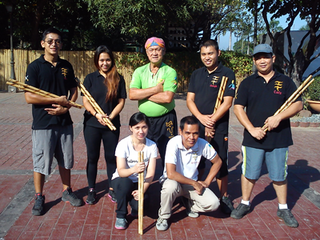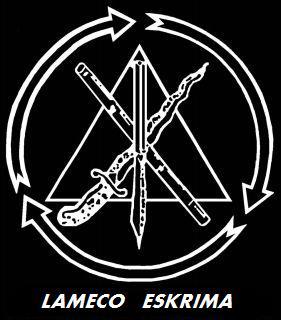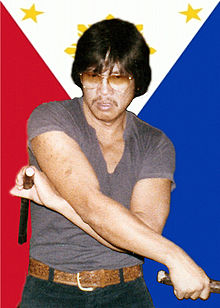Early life and training
Presas was born in the town of Hinigaran, Negros Occidental, Philippines, the son of Jose B. Presas, a businessman, and the former Lucia Amador. He began studying arnis with his father then with his grandfather, Leon Presas, and uncle at the age of six. By the age of fourteen he had his first stick fighting match with a Sinawali master that Presas knocked out with one stick hit. He continued to travel across the Philippine Islands to learn from other masters and to compete in stick-fighting competitions and many street fights. Presas eventually focused on Balintawak Eskrima, but earned a 6th degree black belt in Shotokan Karate and a black belt in judo.He had brothers who also trained Arnis since a young age,Ernesto A Presas,the younger brother of Remy, studied in Japan and learned several martial arts the,the two brothers had learned from their father Jose Bonce Presas and grandfather and other relatives the sow called "family style",which some elements in "Modern Arnis" and in "Arnis Presas style",despite similar methods and development,through the joint efforts of the brothers, the went different routes.Remy moved to the USA, Ernesto stayed in the PH,but travelled extensive teaching Arnis,he spoke highly of Remy and not only told this is the modern Arnis but showed the different ways of the traditional and modern.In 1966 Remy Presas began developing his own system which he called "Modern Arnis" by identifying the basic concepts of the numerous systems he had learned and merging them. By 1969 Modern Arnis had been approved by the Philippine Amateur Athletic Federation as a regular subject to be taught at the National College of Physical education. [2] [3] [4]
Presas was the Arnis consultant in the 1974 Philippines produced film The Pacific Connection. While working on this film he instructed and became friends with US actor Dean Stockwell. [5]
Beginning with a small gymnasium in Bacolod in the 1950s, he attempted to spread the art to the local youth as both a cultural legacy and a form of physical development or sport. Presas instituted a ranking system with Modern Arnis to identify the ability level of each student: likas(green belt), likha(brown belt), and lakan(black belt). Lakan encompassed ten degrees. He issued certificates of rank, and began using the title Guro which became widespread throughout all Filipino Martial Arts Circles. [6] Presas developed what came to be known as the "Arnis Uniform" consisting of loose fitting cotton trousers and a karategi style top low cut at the waist. [7]
In 1982 Presas was inducted into the Black Belt Hall of Fame as Instructor of the Year. In 1994 he was again honored by Black Belt as Weapons Instructor of the Year. [8]
IMAF
Presas formed the International Modern Arnis Federation (IMAF) in 1970 as the principal organization for the promotion and administration of Modern Arnis in North America. The organization was responsible for maintaining records of promotions and other administrative tasks. After the founders death in 2001, these duties have since been past on to (MARPPIO)—operated by the Professors eldest son Remy P. Presas Jr with the aid of the founders other children, and the rest of the Presas Family.
There are two other bifurcated groups, one headed by Jeff Delaney and often referred to as IMAF-Delaney, and the other formerly headed by Randi Schea, often referred to as IMAF-Schea. The latter group is the larger of the two.
There are other notable Modern Arnis organizations, including International Modern Arnis Federation Philippines (IMAFP), based in the Philippines and led by some of the most senior Filipino masters of Modern Arnis; Arnis International founded by Bruce Chiu; a group headed by Tim Hartman (WMAA); a German group headed by Dieter Knuettel (DAV); and others.

Filipino martial arts (FMA) refer to ancient and newer modified fighting methods devised in the Philippines. It incorporates elements from both Western and Eastern Martial Arts; the most popular forms of which are known as Arnis, Eskrima, and Kali. The intrinsic need for self-preservation was the genesis of these systems. Throughout the ages, invaders and evolving local conflict imposed new dynamics for combat in the islands now making up the Philippines. The Filipino people developed battle skills as a direct result of an appreciation of their ever-changing circumstances. They learned, often, out of necessity on how to prioritize, allocate and use common resources in combative situations. Filipinos have been heavily influenced by a phenomenon of cultural and linguistic mixture. Some of the specific mechanisms responsible for cultural and martial change extended from phenomena such as war, political and social systems, technology, and trade and practicality.

Arnis, also known as kali or eskrima/escrima, is the national martial art of the Philippines. These three terms are, sometimes, interchangeable in referring to traditional martial arts of the Philippines, which emphasize weapon-based fighting with sticks, knives, bladed weapons, and various improvised weapons, as well as "open hand" techniques without weapons.

Sikaran is a Filipino Martial Art that involves hand and mostly foot fighting. As Sikaran is a general term for kicking which is also used as the name of the kicking aspects of other Filipino Martial arts, this article discusses the distinct art which is specifically practiced in the Rizal province that focuses almost exclusively in kicking.

Modern Arnis is the system of Filipino fighting arts founded by Remy Presas as a self-defense system. His goal was to create an injury-free training method as well as an effective self-defense system in order to preserve the older Arnis systems. The term Modern Arnis was used by Remy Presas' younger brother Ernesto Presas to describe his style of Filipino martial arts; since 1999 Ernesto Presas has called his system Kombatan. It is derived principally from the traditional Presas family style of the Bolo (machete) and the stick-dueling art of Balintawak Eskrima, with influences from other Filipino and Japanese martial arts.
Doce Pares is a Filipino martial art and a form of Arnis, Kali and Eskrima, that focuses primarily on stick fighting, knife fighting and hand-to-hand combat but also covers grappling and other weapons as well. In reality, the stick is merely considered an extension of the hand, and is meant to represent almost any weapon, from sticks to swords to knives to anything else you can place in your hand and use as a weapon in the modern context. Doce Pares was founded in 1932.
San Miguel Eskrima is one of the major systems of eskrima, a martial arts from the Philippines. Founded by Filemon "Momoy" Cañete of the Doce Pares Club, SME served as vehicle for his own personal expression of the art and methodology of the club of which he was a co-founder and instructor. The name San Miguel is taken from Michael (archangel), the slayer of Satan, and is one of the major strikes used in Eskrima.

Kombatan is a Filipino martial arts system. The founder of the system was GGM Ernesto Amador Presas. The current head of the system is Ernesto Presas Jr. The style is known for its double stick techniques, but it features other stick and blade techniques, as well as empty-hand methods.

Balintawak Eskrima or Balintawak Arnis is a Filipino martial art created by Grandmaster Venancio "Anciong" Bacon in the 1950s to enhance and preserve the combative nature of arnis which he felt was being watered down by other styles of Philippine martial arts. It is named after a small street in Cebu where it was founded.
Tim Hartman is a practitioner of the Filipino martial art of modern arnis and balintawak eskrima, and the president of the World Modern Arnis Alliance (WMAA).
Shishir Inocalla is a grand master of Filipino martial arts, Yoga and meditation. He was the first of 6 men named as Datu by the late Remy Presas, Founder of Modern Arnis. He is an accomplished martial artist, Yogi as well as noted actor with movie credits including: Ninja Turtles, Pinoy Boxer, Five Style Fist, Crazy Kung Fu and The Ultimate Fight. [9] [10]He played “Michaelangelo” in Teenage Mutant Ninja turtle 3 Movie and TV series. is also a balisong expert and Hilot healer. [4.]Master Shishir Inocalla became the mind body inner heart trainer for David Leadbetter golf Academy in Championsgate since 2003 and Zone golf Academy in Richmond, BC Canada. He created Arnis chigolf and heartful training from the heart. [5]He co star and co produced “The Process” aka “ultimate Fight” movie. [6]He revived Modern Arnis In the Philippines under GM Remy Presas and became President of Modern Arnis. Canada and Vice President of International Arnis Federation Iarnis. He also formed Sport Arnis to be approved sport in Canada, USA, Brazil and other countries www.Sportarniscanad.org. Together with his family They Created Maharlika Institute for higher learning and www.paracalegoldcorp.com creating self sufficient agro-green mining in his family farm Paracale/Mambulao, Camarines Norte, Philippines. www.mastershishir.com

Grandmaster Vicente "Vic" R. Sanchez was a Filipino martial artist and the founder of Kali Arnis International.

Lameco Eskrima is the system of Filipino martial arts founded by Edgar Sulite based on his training and experience with various Philippine Martial Arts masters, with heavy influence from Jose Caballero and Antonio Ilustrisimo.
Small Circle Jujitsu is a style of jujutsu developed by Wally Jay that focuses on employing dual simultaneous push/pull actions and smooth transitions.
Ciriaco "Cacoy" Cañete was a Filipino martial artist of the Doce Pares Eskrima Club. He was the last surviving member of the club, which was founded in January 1932. He was also a 12th degree black belt. His version of the Doce Pares Eskrima system is known as Cacoy Doce Pares. In 1951 he developed a personal system of his named Eskrido.
Arthur Alvin A. Aguilar is a Filipino martial artist and mixed martial arts promoter better known as Alvin Aguilar. He was born on April 28, 1974, in Bacolod, Philippines. He is the president and founder of the Universal Reality Combat Championship (2002–present); He is also the founder and head coach of DEFTAC Ribeiro Jiu-jitsu Philippines (1996–present.) and is currently serving as the president of the Wrestling Association of the Philippines. He started training in martial arts at the age of 9, first in Karate, Arnis and Greco-Roman wrestling. Having spent over 30 years of his life to the study of multiple martial arts forms including Sari-an, Brazilian jiu-jitsu, Yaw-Yan, Pekiti Tirsia Kali, etc., he has developed his own unique fighting style specialized in grappling, knife, and street fighting. He is also known for being the first home-grown Filipino Brazilian jiu-jitsu black belt.

In early Philippine history, the rank of lakan denoted a "paramount ruler" of one of the large coastal barangays on the central and southern regions of the island of Luzon.
Arnis in popular culture reflects the impact that the Filipino martial arts of arnis/eskrima/kali have made outside of the martial arts community. The three terms are roughly interchangeable and for the purpose of convenience, the term arnis will be used throughout the article. These arts emphasize weapon-based fighting with sticks, blades, improvised weapons and hand-to-hand fighting which is formally known as Mano Mano or Pangamut. Because of this training with live weapons, elements of arnis have made an impact in film, video games, television, and comic books. Arnis is often used to train actors and stuntmen how to handle similar weapons for use in movies.
Black Scorpion Arnis is a distinct Filipino martial art first developed in the late 1960s that focuses on self-defense. The hands and feet are used extensively in most of the styles moves.

The baston is one of the primary weapons of Arnis and Filipino martial arts. It is also known as yantok, olisi, palo, pamalo, garrote, caña, cane, arnis stick, eskrima stick or simply, stick.










